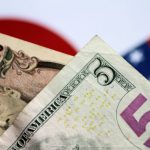
TOKYO (Reuters) -The yen strengthened on Wednesday as investors firmed up bets that the Bank of Japan will exit stimulus in coming months, while the dollar broadly held its ground against major rivals amid expectations that the Federal Reserve won’t rush to cut interest rates.
The Japanese currency gained as much as 0.41% to 147.76 per dollar during Tokyo trading hours as Japanese government bond yields leapt to six-week highs after central bank chief Kazuo Ueda said on Tuesday that the prospects of achieving the BOJ’s inflation target were gradually increasing.
The yen got an additional tailwind from a pullback in long-term U.S. Treasury yields in Wednesday trading, which the dollar-yen pair tends to track, as traders fine-tuned Fed easing wagers.
The dollar was down 0.3% at 147.90 yen as of 0624 GMT, although its gain for the year is still almost 5% amid lessening expectations of early Fed cuts and, until Tuesday’s hawkish tilt, a pushing back of bets for a BOJ stimulus exit.
“Ueda’s comments have given the market a little more confidence that April is definitely a live date for a potential exit from the current policy,” said Ray Attrill, head of FX research at National Australia Bank (OTC:NABZY).
At the same time, “near term, I’d say a test of 150 is much more likely than a move down to the 145 area” for dollar-yen, because the currency pair is susceptible to a move upwards in Treasury yields after a too-aggressive pricing out of near-term Fed rate cut risks, Attrill said.
“Our view is March is still very much a live meeting.”
The U.S. rate futures market on Tuesday priced in a roughly 47% chance of a March rate cut, up from late on Monday, but down from as much 80% about two weeks ago, according to LSEG’s rate probability app.
For 2024, futures traders are betting on five quarter-point rate cuts. Two weeks ago they expected six.
The U.S. dollar index – which tracks the currency against six rivals, including the yen and euro – ticked down 0.07% to 103.43, but didn’t stray far from the highest level since Dec. 13 at 103.82, reached in the previous session.
In the last comments before Fed officials entered a blackout period ahead of their Jan. 31 policy decision, San Francisco Fed President Mary Daly said Friday she believes monetary policy is in a “good place” and it is premature to think rate cuts are imminent.
Earlier that week, Fed Governor Christopher Waller said policymakers would move “carefully and slowly”, which traders took as pushing back at pricing for a speedy fall in rates.
“Markets have been correcting from the narrative that rate cuts were incoming, and incoming quickly,” leading to dollar strength, said James Kniveton, senior corporate FX dealer at Convera.
“This follows a general pattern of resistance to inflation reduction the closer central banks get to their final target, and has caused a rethinking of how fast monetary policy would return to lower levels,” he added. “We have seen ECB (European Central Bank) officials push back on rate cut expectations as well, in line with the Federal Reserve.”
The ECB decides policy on Thursday. No change in interest rates is expected, but investors will watch the tone of the statement and central bank chief Christine Lagarde’s press conference for clues on where rates are headed.
The euro added 0.11% to $1.0864, after slipping as low as $1.0822 on Tuesday for the first time since Dec. 13.
Sterling was 0.13% higher at $1.2703, making up some ground following an overnight dip of 0.2%. The Bank of England announces its policy decision on Feb. 1.
The Bank of Canada meets on policy on Wednesday, and is expected to leave its key overnight rate unchanged at a 22-year high of 5%. The greenback rose slightly to C$1.34695, after slipping 0.15% on Tuesday.
Elsewhere, cryptocurrency bitcoin steadied around $39,700, after sliding as low as $38,505 on Tuesday for the first time since Dec. 1.
Traders have unwound bullish positions built up in anticipation of U.S. approval of the country’s first spot bitcoin exchange traded fund (ETF).
Bitcoin had surged to a record $49,048 on Jan. 11, a day after the approval, but tumbled as low as $41,509 in the subsequent session as traders dumped the token in a textbook sell-the-fact move.
To read the full article, Click Here

